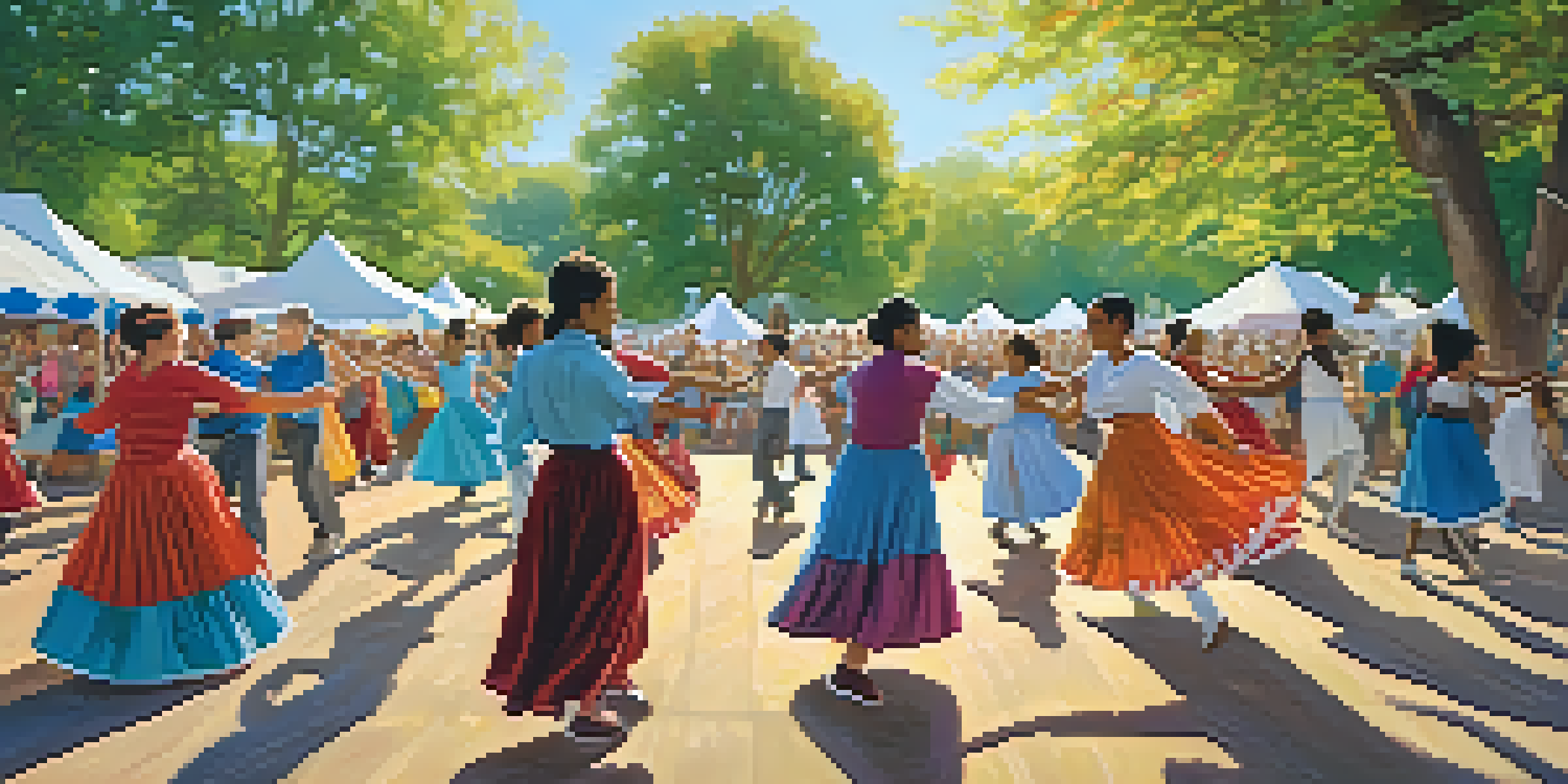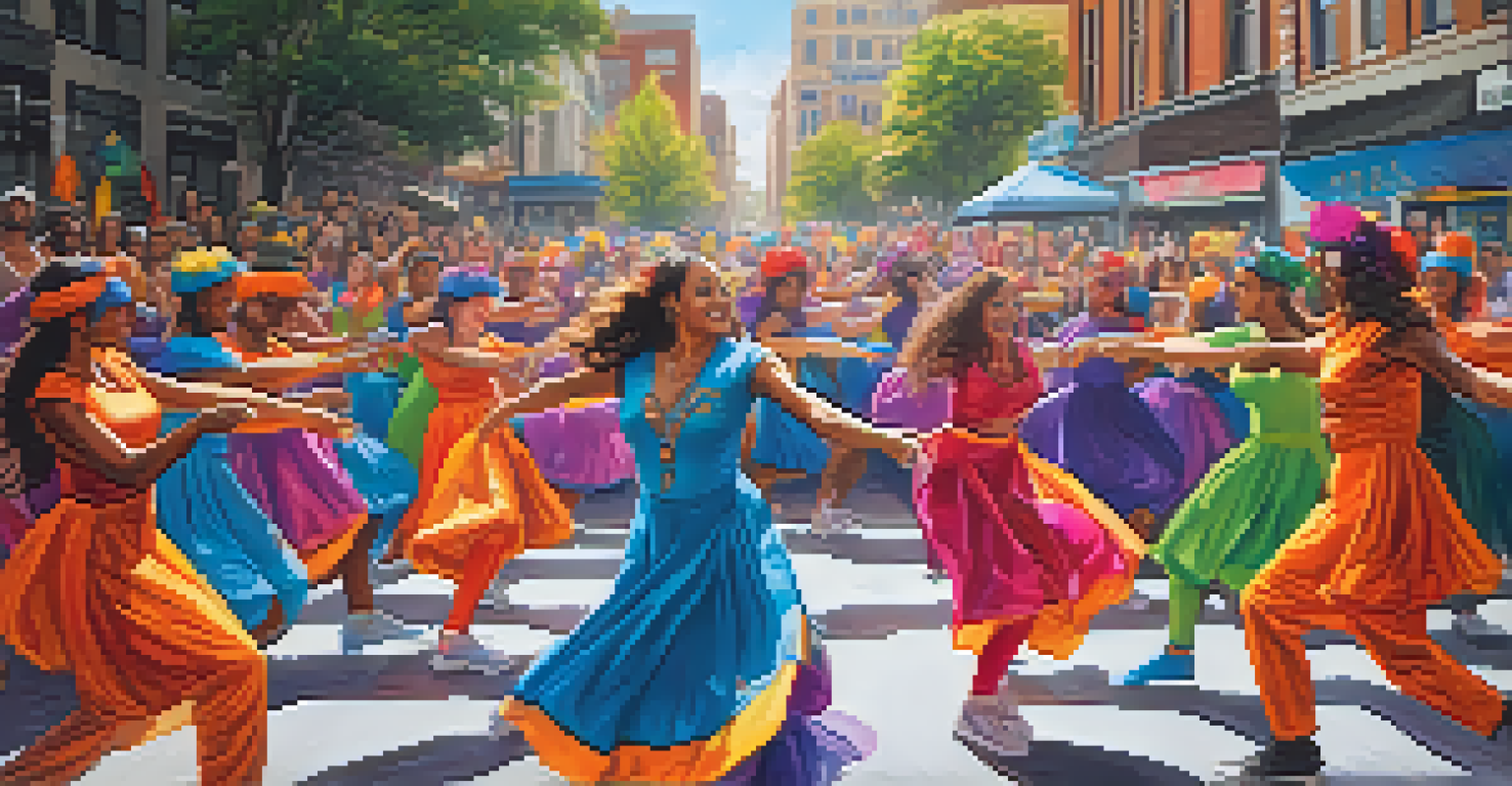The Role of Dance in Enhancing Global Community Health Initiatives

Understanding the Connection Between Dance and Health
Dance is more than just an art form; it’s a powerful tool for promoting health. Engaging in dance activities can enhance physical fitness, mental well-being, and social connectivity. When people dance, they not only get their bodies moving, but they also release endorphins that improve mood and reduce stress.
Dance is the hidden language of the soul.
For example, a simple dance class can serve as a fun alternative to traditional exercise, making it easier for people to stay active. Additionally, the social aspects of group dance can help alleviate feelings of loneliness and isolation, which are common in today’s fast-paced world. Thus, dance becomes a holistic approach to health that encompasses body, mind, and community.
As we look at global health initiatives, integrating dance into these programs can lead to more inclusive and effective strategies. By recognizing the benefits of dance, health promoters can foster environments where individuals not only benefit personally but also support one another in their wellness journeys.
Dance as a Community-Building Tool
One of the most beautiful aspects of dance is its ability to bring people together. Whether it's through traditional folk dances or modern styles, communities can bond over shared experiences and cultural expressions. This unity is essential in creating a supportive environment for health initiatives, where collective action can lead to greater impact.

For instance, community dance events often serve as platforms for raising awareness about health issues, like diabetes or mental health. They engage participants in fun and meaningful ways, transforming awareness into action. When people dance together, they create a sense of belonging that encourages them to participate in health-promoting activities.
Dance Boosts Physical and Mental Health
Engaging in dance activities enhances physical fitness, improves mood, and fosters social connections.
Moreover, these events can break down barriers between diverse groups, promoting inclusivity and understanding. In this way, dance not only enhances individual health but also strengthens community ties, making it an invaluable element in global health initiatives.
Dance Therapy: A Growing Field in Health Initiatives
Dance therapy is an emerging discipline that combines movement and psychology to improve mental health. By using dance as a form of expression, therapists can help individuals process emotions and trauma in a safe environment. This method has been particularly effective for populations dealing with stress, anxiety, and depression.
Dance enables you to find yourself and lose yourself at the same time.
In recent years, dance therapy programs have gained traction in various healthcare settings, from hospitals to community centers. For example, cancer patients often participate in dance therapy to cope with the emotional toll of their diagnosis. Through movement, they can express feelings that might be difficult to articulate, fostering healing on both physical and emotional levels.
As more health professionals recognize the benefits of dance therapy, we’re likely to see it integrated into broader health initiatives. This approach not only addresses individual needs but also highlights the importance of creative expression in overall wellness.
Dance and Cultural Heritage in Health Programs
Cultural heritage plays a significant role in shaping community identities, and dance is a vital expression of that heritage. Many health initiatives incorporate traditional dance forms to engage communities in meaningful ways. This not only preserves cultural practices but also promotes physical activity and social interaction.
For instance, Indigenous communities often use traditional dance as a way to promote health and well-being. By celebrating their cultural identities through dance, they can strengthen community bonds while addressing health disparities. Such initiatives empower individuals to take charge of their health while honoring their cultural roots.
Dance Fosters Community and Advocacy
Dance serves as a powerful tool for community building and advocacy, raising awareness about health issues through creative expression.
Including cultural dance in health programs can also attract a wider audience, making health initiatives more relatable and accessible. This approach fosters a sense of pride and ownership that can significantly enhance the effectiveness of health campaigns.
Dance as a Form of Advocacy in Health Initiatives
Dance can be a powerful form of advocacy, raising awareness about important health issues. Through performances and flash mobs, dancers can convey messages that resonate with audiences, encouraging them to take action. This creative approach to advocacy can capture attention in ways that traditional methods may not.
For example, campaigns addressing mental health often use dance to break the stigma surrounding these issues. By showcasing personal stories through movement, dancers can inspire empathy and understanding. This not only engages audiences but also creates a platform for dialogue about mental health challenges.
By harnessing the expressive power of dance, health advocates can create memorable experiences that lead to lasting impact. This blend of art and advocacy can motivate individuals to get involved and support health initiatives in their communities.
Global Success Stories: Dance in Health Initiatives
Around the world, various health initiatives successfully integrate dance to promote well-being. One notable example is the 'Dancing with the Stars' program in the UK, which encourages older adults to engage in physical activity through dance. This initiative not only improves fitness but also combats social isolation among seniors.
Similarly, in Brazil, the 'Dance for Life' program has been instrumental in addressing obesity and lifestyle diseases among youth. By incorporating popular dance styles, this initiative captures the interest of young people, making exercise enjoyable and relatable. The program has seen significant improvements in participants' physical health and self-esteem.
Cultural Dance Preserves Heritage
Incorporating traditional dance in health initiatives strengthens community bonds while promoting physical activity and cultural pride.
These success stories highlight the potential of dance to create positive health outcomes globally. As more communities embrace dance as a tool for health, the ripple effects can lead to significant changes in public health landscapes.
Challenges and Considerations in Dance Health Initiatives
While dance has many benefits, there are challenges in implementing dance-based health initiatives. One issue is ensuring accessibility for all individuals, regardless of physical ability. Programs must be designed to accommodate diverse populations, including those with disabilities or limited mobility.
Additionally, cultural sensitivity is crucial when incorporating dance into health initiatives. It's important to respect and honor cultural practices while promoting health, avoiding appropriation or misrepresentation. Engaging community leaders and dancers can help ensure that programs are inclusive and culturally relevant.

Lastly, measuring the impact of dance on health outcomes can be complex. Establishing clear metrics and evaluation methods is essential for demonstrating the effectiveness of dance initiatives. By addressing these challenges, we can create more robust and successful dance programs that truly enhance community health.